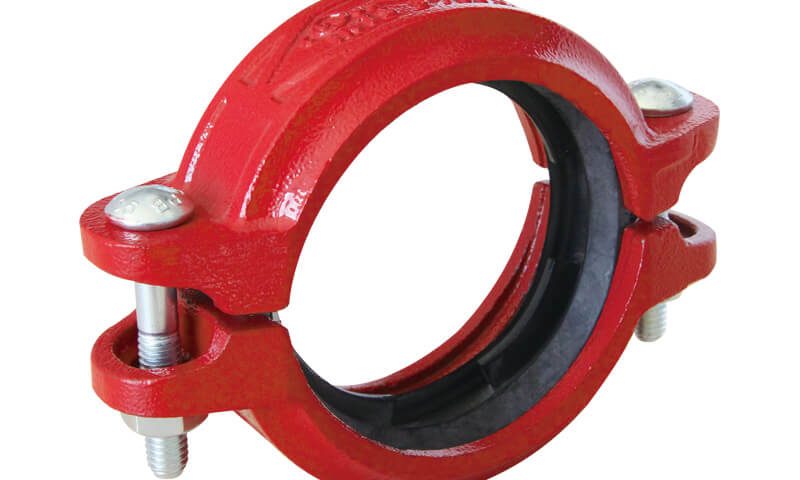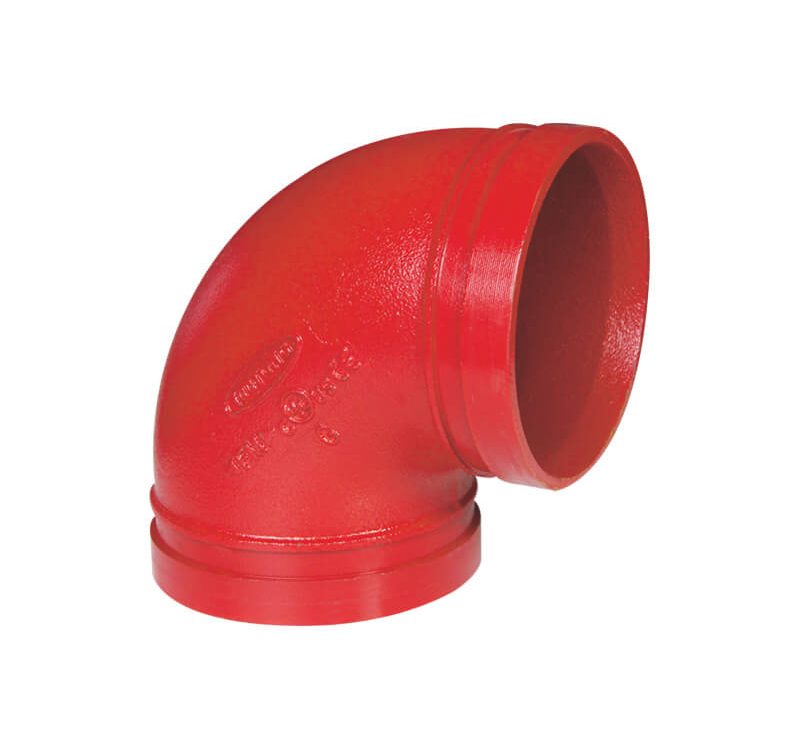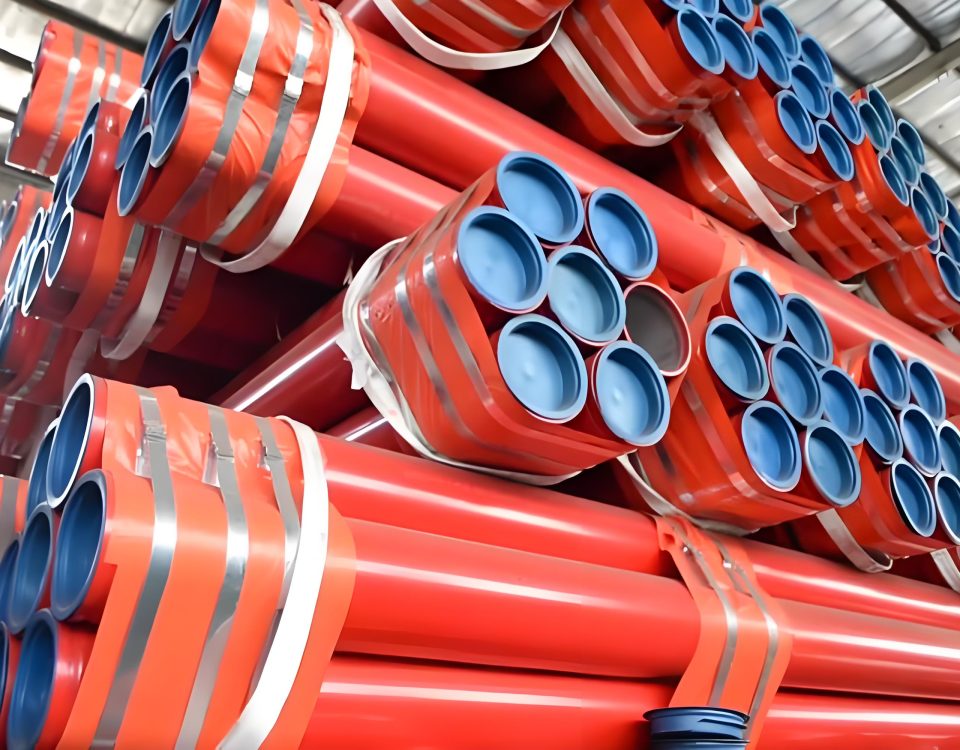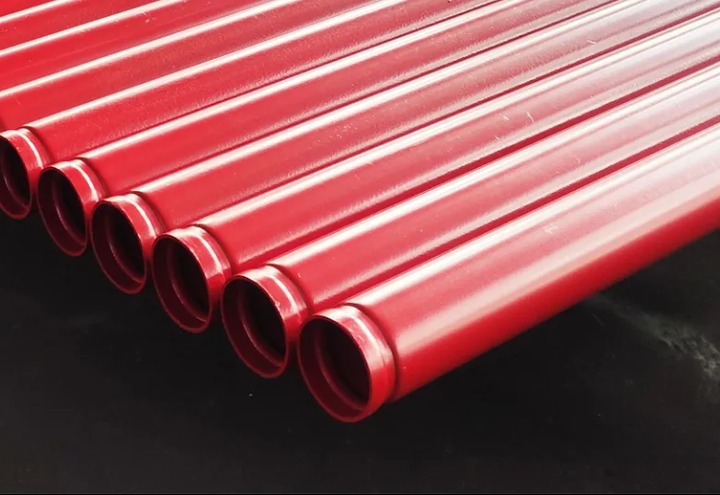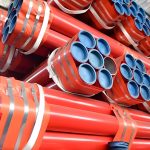
A795 steel fire sprinkler pipe | Sch 10 and Sch 40 fire sprinkler
June 22, 2025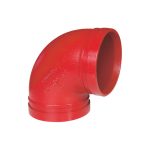
Ductile Iron Grooved Pipe Elbow Fitting
June 28, 2025Comprehensive Analysis of Grooved Pipe Coupling Fittings: Types, Sizes, Parameters, and Comparative Data
Grooved pipe coupling fittings are a cornerstone of modern piping systems, offering a versatile, reliable, and efficient method for connecting pipes across various applications, from fire protection to industrial and commercial plumbing. This article provides an in-depth exploration of ten specific types of grooved pipe couplings—rigid grooved coupling, flexible grooved coupling, heavy-duty rigid grooved coupling, heavy-duty flexible grooved coupling, reducing flexible grooved coupling, quick rigid grooved coupling, Quikcoup one-bolt rigid grooved coupling, quick flexible grooved coupling, plain end HDPE coupling, and transition HDPE to steel coupling.
1. Rigid Grooved Coupling
Overview and Applications
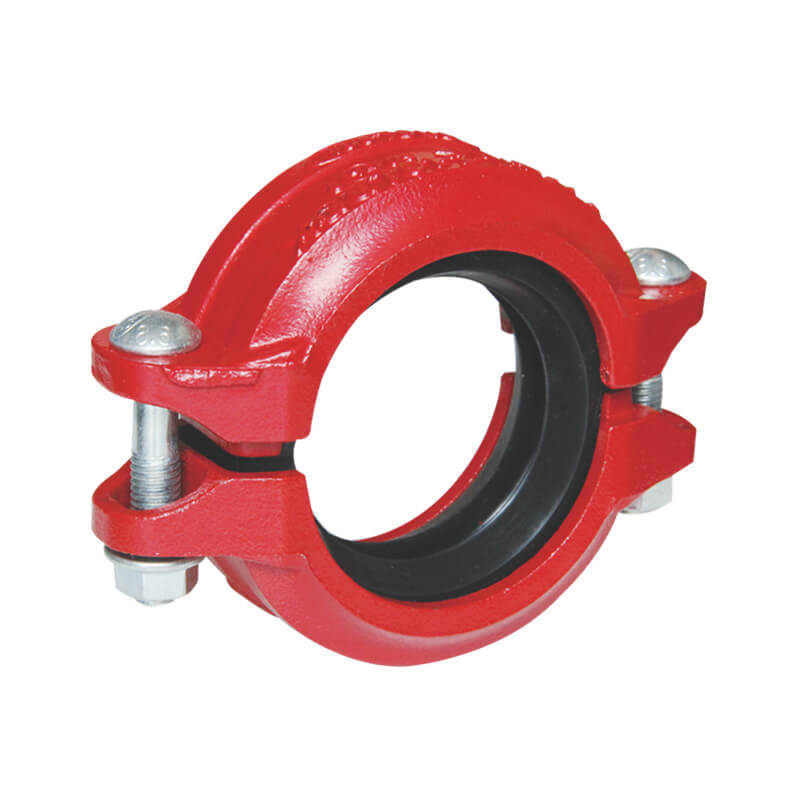
Rigid grooved couplings create a secure, non-flexible connection between pipes, mimicking the rigidity of a welded or flanged joint. They are widely used in applications requiring stability, such as fire protection systems, HVAC, and industrial pipelines. By engaging grooves on pipe ends with a housing equipped with grip teeth, these couplings ensure a leak-tight, self-restrained joint without allowing movement. Their UL/FM certifications make them a trusted choice for critical systems.
Pipe Sizes and Parameters
Rigid grooved couplings are available in nominal pipe sizes ranging from 1″ to 24″ (DN25 to DN600). Common materials include ductile iron for the housing, with EPDM, nitrile, or silicone rubber gaskets depending on the medium (e.g., water, oil, or chemicals). Bolts and nuts are typically carbon steel or stainless steel, with maximum working pressures up to 300 PSI (UL/FM rated) for fire protection and higher for industrial applications. The coupling’s torque rating varies by size, typically 80–120 ft-lbs for 4″ pipes.
| Size (Nominal) | Max. Working Pressure (PSI) | Gasket Material | Bolt Torque (ft-lbs) | Weight (lbs) |
|---|---|---|---|---|
| 2″ (DN50) | 300 | EPDM/Nitrile | 60–80 | 3.5 |
| 4″ (DN100) | 300 | EPDM/Nitrile | 80–120 | 7.0 |
| 8″ (DN200) | 250 | EPDM/Silicone | 120–160 | 15.0 |
Detailed Analysis
The rigid grooved coupling’s primary advantage lies in its ability to maintain pipeline alignment under high pressure or axial loads. Unlike flexible couplings, it prevents angular deflection or axial movement, which is critical in systems where vibration or thermal expansion is minimal. The grip teeth within the housing bite into the pipe’s groove, creating a mechanical lock that exceeds the pressure rating of the pipe itself. Installation is straightforward: the gasket is placed over the pipe ends, the housing is aligned, and bolts are tightened to the specified torque. This eliminates the need for welding, reducing labor costs by up to 50% compared to flanged systems.
However, rigid couplings are less forgiving in misaligned systems or areas prone to seismic activity, where flexibility is needed. Their weight, while moderate, can be a consideration for large-diameter pipes. Maintenance is minimal, as the couplings allow for easy disassembly and reassembly, making them ideal for systems requiring periodic cleaning or modification.
Comparative Data
Compared to flexible couplings, rigid grooved couplings offer superior stability but lack movement accommodation. For instance, in a 4″ fire protection system, a rigid coupling maintains a fixed joint with zero deflection, while a flexible coupling allows up to 1.5° angular movement. Pressure ratings are similar, but rigid couplings excel in applications with high axial forces, such as vertical risers. Cost-wise, rigid couplings are typically 10–15% cheaper than heavy-duty variants due to simpler design.
2. Flexible Grooved Coupling
Overview and Applications
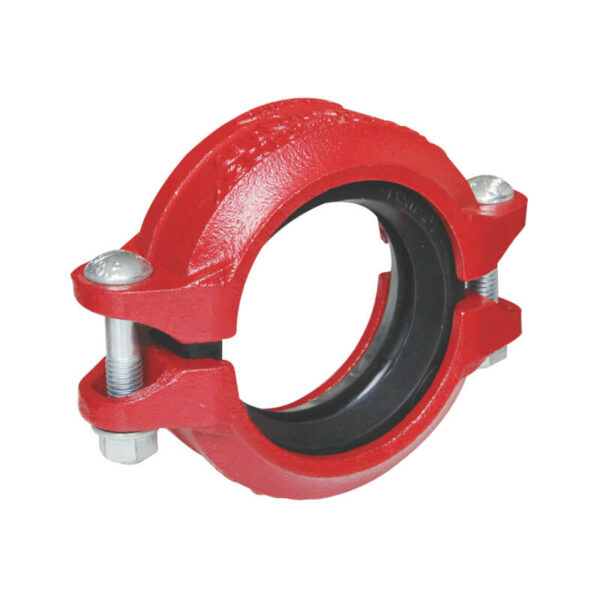
Flexible grooved couplings are engineered to accommodate controlled linear and angular movement, making them ideal for systems subject to thermal expansion, contraction, or seismic activity. They are prevalent in HVAC, plumbing, and industrial systems where pipeline deflection or vibration dampening is necessary. These couplings maintain a leak-tight seal while allowing flexibility, certified by UL/FM for reliability.
Pipe Sizes and Parameters
Flexible grooved couplings cover pipe sizes from 1″ to 24″ (DN25 to DN600). The housing is typically ductile iron, with gaskets made of EPDM (for water), nitrile (for oil), or silicone (for high temperatures). Maximum working pressures range from 300 PSI for smaller sizes to 250 PSI for larger diameters. Angular deflection varies by size, typically 1–2° for 4″ pipes.
| Size (Nominal) | Max. Working Pressure (PSI) | Angular Deflection (°) | Gasket Material | Weight (lbs) |
|---|---|---|---|---|
| 2″ (DN50) | 300 | 2.0 | EPDM/Nitrile | 3.8 |
| 4″ (DN100) | 300 | 1.5 | EPDM/Nitrile | 7.5 |
| 8″ (DN200) | 250 | 1.0 | EPDM/Silicone | 16.0 |
Detailed Analysis
Flexible grooved couplings excel in dynamic environments. Their design allows for controlled movement, reducing stress on pipes and equipment caused by thermal changes or external forces. The gasket, encased within the housing, forms a pressure barrier, while robust bolts and nuts tightened to 60–120 ft-lbs ensure integrity. Installation is rapid, with no welding or threading required, offering 2–4x faster assembly than traditional methods. This makes them a favorite in retrofit projects or tight spaces.
The trade-off is reduced rigidity, which may lead to misalignment over time in high-pressure systems. Flexible couplings are also slightly more expensive than rigid ones, due to their complex housing design. Regular inspection ensures gasket performance, especially in corrosive environments where material compatibility is critical.
Comparative Data
Flexible couplings allow up to 2° deflection in 4″ pipes, compared to zero for rigid couplings. This flexibility reduces the need for expansion joints, saving 20–30% in system costs. However, their pressure ratings are similar to rigid couplings, and they are less suited for vertical applications due to potential axial movement. In seismic zones, flexible couplings outperform rigid ones by absorbing vibrations, as evidenced by their use in earthquake-prone regions.
3. Heavy-Duty Rigid Grooved Coupling
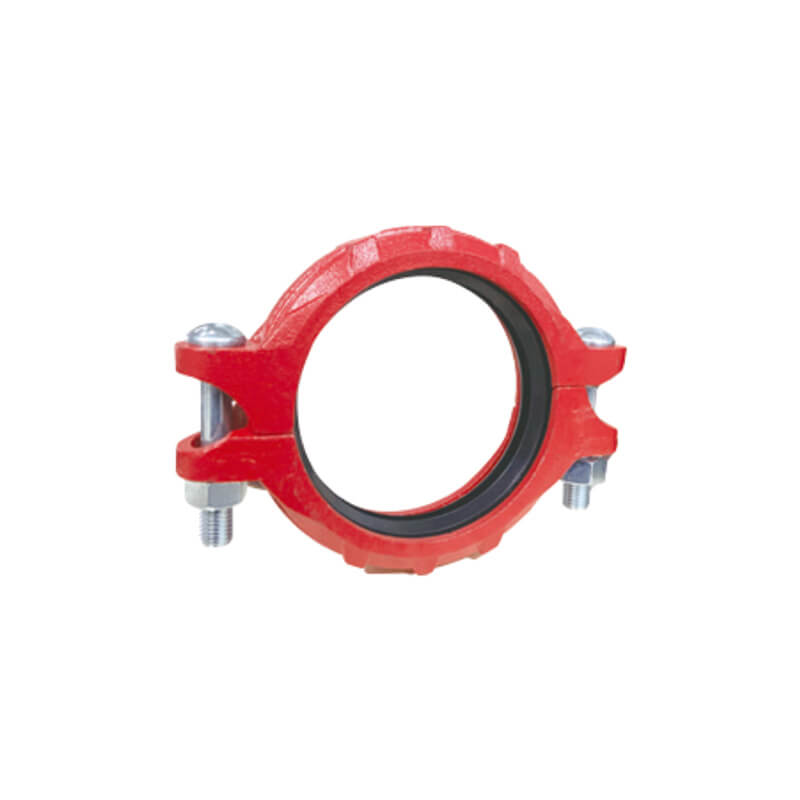
Overview and Applications
Heavy-duty rigid grooved couplings are engineered for high-pressure or high-torque applications, such as oil and gas pipelines or heavy industrial systems. They provide a rigid, non-flexible joint with enhanced grip strength, ensuring maximum stability under demanding conditions. UL/FM certifications validate their use in critical fire protection systems.
Pipe Sizes and Parameters
Available in sizes from 2″ to 24″ (DN50 to DN600), heavy-duty rigid couplings handle pressures up to 500 PSI in smaller sizes. The housing is thicker ductile iron, with reinforced bolts (carbon or stainless steel). Gaskets are typically EPDM or nitrile, with torque ratings up to 200 ft-lbs for 8″ pipes.
| Size (Nominal) | Max. Working Pressure (PSI) | Gasket Material | Bolt Torque (ft-lbs) | Weight (lbs) |
|---|---|---|---|---|
| 4″ (DN100) | 400 | EPDM/Nitrile | 120–160 | 10.0 |
| 8″ (DN200) | 350 | EPDM/Nitrile | 180–200 | 20.0 |
| 12″ (DN300) | 300 | EPDM/Silicone | 250–300 | 35.0 |
Detailed Analysis
Heavy-duty rigid couplings are built for extreme durability. Their reinforced housing withstands higher pressures and axial forces than standard rigid couplings, making them suitable for oil refineries or high-rise buildings. The grip teeth provide a mechanical lock, preventing pipe pull-out even under surge conditions. Installation requires higher torque settings, but the process remains efficient, saving 30–40% labor compared to flanged systems.
Their weight and cost are higher, making them less ideal for low-pressure applications. Like standard rigid couplings, they offer no flexibility, limiting their use in seismic zones. Maintenance involves periodic torque verification to ensure joint integrity, particularly in high-vibration environments.
Comparative Data
Heavy-duty rigid couplings offer up to 30% higher pressure ratings than standard rigid couplings but are 20–25% heavier. Compared to heavy-duty flexible couplings, they lack movement accommodation but excel in high-pressure stability. In a 6″ gas pipeline, a heavy-duty rigid coupling supports 400 PSI, while a standard flexible one supports only 300 PSI, highlighting its specialized role.
4. Heavy-Duty Flexible Grooved Coupling
Overview and Applications
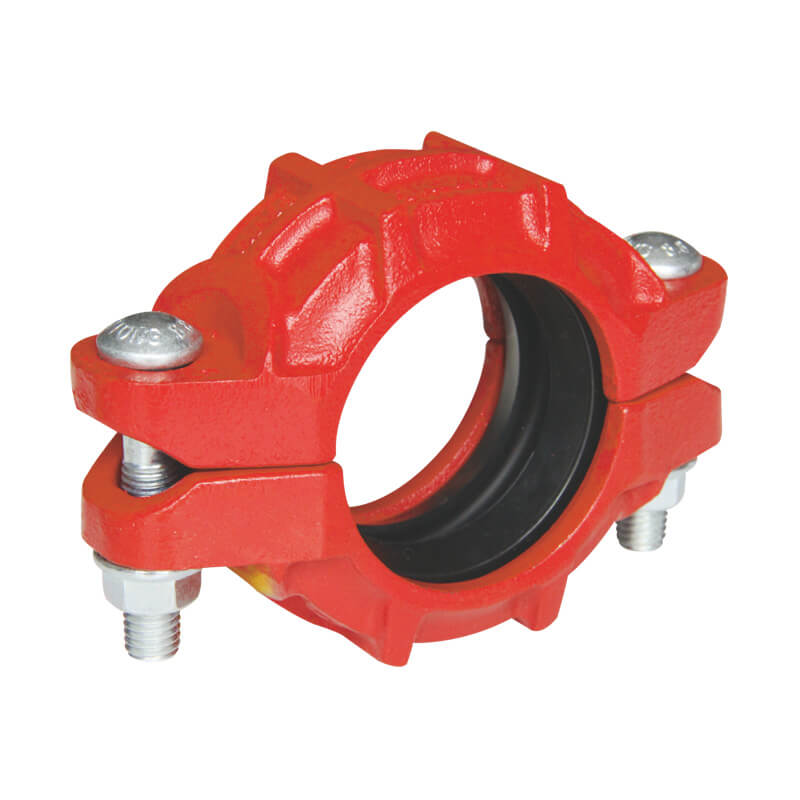
Heavy-duty flexible grooved couplings combine flexibility with high-pressure performance, ideal for industrial applications like mining, petrochemicals, or marine systems. They accommodate linear and angular movement while maintaining a leak-tight seal, certified by UL/FM for fire protection and other critical uses.
Pipe Sizes and Parameters
Sizes range from 2″ to 24″ (DN50 to DN600), with pressures up to 450 PSI. The housing is ductile iron, with EPDM or nitrile gaskets and reinforced bolts. Angular deflection is typically 1–3° for 4″ pipes, with torque ratings up to 180 ft-lbs.
| Size (Nominal) | Max. Working Pressure (PSI) | Angular Deflection (°) | Gasket Material | Weight (lbs) |
|---|---|---|---|---|
| 4″ (DN100) | 400 | 2.0 | EPDM/Nitrile | 12.0 |
| 8″ (DN200) | 350 | 1.5 | EPDM/Silicone | 22.0 |
| 12″ (DN300) | 300 | 1.0 | EPDM | 38.0 |
Detailed Analysis
These couplings balance flexibility and high-pressure capability, reducing stress in dynamic systems while handling heavy loads. Their robust housing allows controlled movement, ideal for thermal expansion in steam lines or seismic activity in industrial plants. Installation is efficient, with no need for fusion equipment, saving 2–3x time over welded joints. The gasket’s design ensures sealing under high pressure, with bolts tightened to precise torque levels.
The increased weight and complexity raise costs compared to standard flexible couplings. Regular maintenance includes checking gasket wear, especially in abrasive media. They are less suited for low-pressure systems where standard flexible couplings suffice.
Comparative Data
Heavy-duty flexible couplings support 1–3° deflection and 400 PSI in 4″ pipes, compared to 300 PSI for standard flexible couplings. They outperform heavy-duty rigid couplings in seismic applications but are 15–20% more expensive. In mining pipelines, their flexibility reduces equipment stress, extending system life by 10–15%.
5. Reducing Flexible Grooved Coupling
Overview and Applications
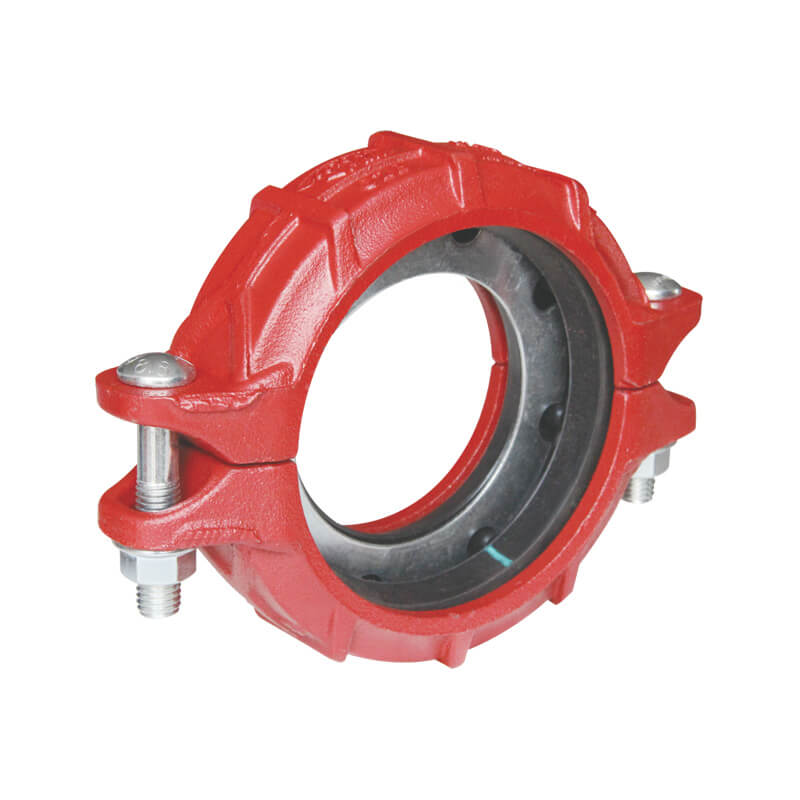
Reducing flexible grooved couplings connect pipes of different diameters while allowing controlled movement, used in HVAC, plumbing, and industrial systems. They accommodate thermal expansion and vibration, with UL/FM approvals for reliability.
Pipe Sizes and Parameters
Available for pipe size combinations like 2″ x 1.5″ to 12″ x 8″ (DN50 x DN40 to DN300 x DN200), they handle pressures up to 300 PSI. Gaskets are EPDM or nitrile, with ductile iron housings and carbon steel bolts. Angular deflection is typically 1–2°.
| Size (Nominal) | Max. Working Pressure (PSI) | Angular Deflection (°) | Gasket Material | Weight (lbs) |
|---|---|---|---|---|
| 4″ x 3″ | 300 | 1.5 | EPDM/Nitrile | 8.0 |
| 6″ x 4″ | 300 | 1.2 | EPDM/Nitrile | 12.0 |
| 8″ x 6″ | 250 | 1.0 | EPDM/Silicone | 18.0 |
Detailed Analysis
Reducing flexible couplings simplify transitions between pipe sizes, eliminating the need for additional fittings. Their flexibility accommodates misalignment and thermal changes, making them ideal for retrofits or complex layouts. Installation is quick, with bolts tightened to 80–120 ft-lbs, saving 30–50% labor over threaded systems. The gasket ensures a leak-tight seal across diameter differences.
Their cost is higher than standard couplings due to specialized design, and they are less suited for high-pressure or rigid applications. Maintenance involves checking gasket compatibility with the medium and ensuring proper torque.
Comparative Data
Reducing flexible couplings allow 1.5° deflection in 4″ x 3″ joints, similar to standard flexible couplings but with size adaptability. They reduce fitting costs by 20–25% compared to using separate reducers. In HVAC systems, their flexibility minimizes vibration, enhancing system longevity.
6. Quick Rigid Grooved Coupling
Overview and Applications
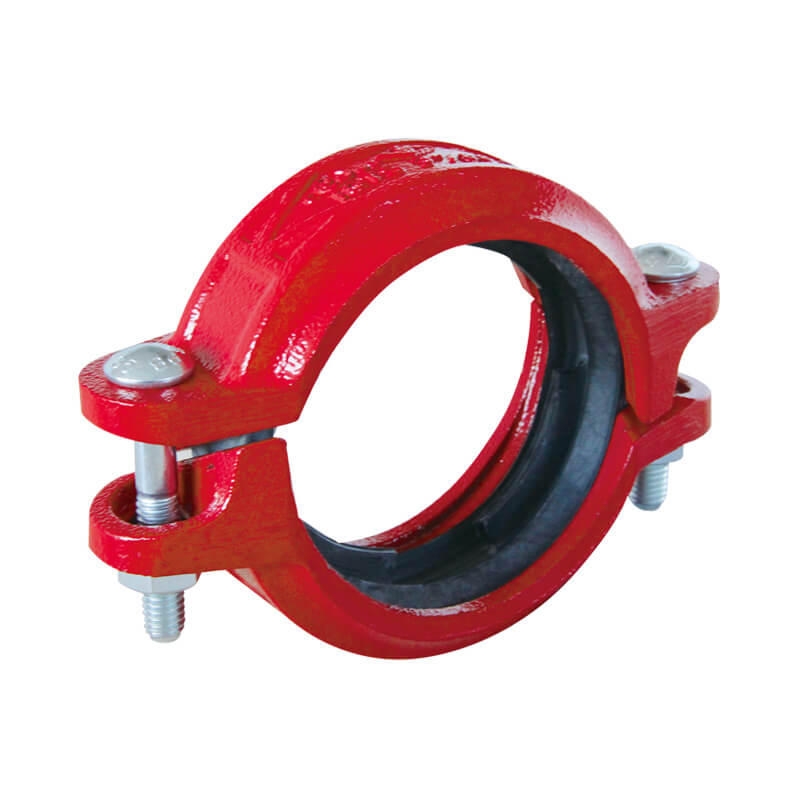
Quick rigid grooved couplings prioritize fast installation while maintaining rigidity, ideal for fire protection, plumbing, and industrial systems. Their design reduces bolt-tightening time, certified by UL/FM for reliability.
Pipe Sizes and Parameters
Sizes range from 1″ to 12″ (DN25 to DN300), with pressures up to 300 PSI. The housing is ductile iron, with EPDM or nitrile gaskets and fewer bolts than standard rigid couplings. Torque is typically 60–100 ft-lbs.
| Size (Nominal) | Max. Working Pressure (PSI) | Gasket Material | Bolt Torque (ft-lbs) | Weight (lbs) |
|---|---|---|---|---|
| 2″ (DN50) | 300 | EPDM/Nitrile | 60–80 | 3.2 |
| 4″ (DN100) | 300 | EPDM/Nitrile | 80–100 | 6.5 |
| 8″ (DN200) | 250 | EPDM/Silicone | 100–120 | 14.0 |
Detailed Analysis
Quick rigid couplings streamline installation, reducing labor time by 20–30% compared to standard rigid couplings. Their grip teeth ensure a rigid joint, suitable for high-pressure systems with minimal movement. The simplified bolt design maintains performance while cutting assembly time, ideal for tight schedules or confined spaces.
They are less suited for dynamic systems requiring flexibility and may cost slightly more due to specialized engineering. Maintenance is minimal, focusing on torque checks and gasket condition.
Comparative Data
Quick rigid couplings match standard rigid couplings in pressure (300 PSI for 4″) but install 25% faster. Compared to quick flexible couplings, they offer no deflection but excel in fixed alignments. In fire protection, their speed reduces project timelines significantly.
7. Quikcoup One-Bolt Rigid Grooved Coupling

Overview and Applications
Quikcoup one-bolt rigid grooved couplings are designed for ultra-fast installation, using a single bolt to secure a rigid joint. They are used in fire protection, plumbing, and low-pressure industrial systems where speed is critical.
Pipe Sizes and Parameters
Available in 1″ to 6″ (DN25 to DN150), they handle pressures up to 250 PSI. The housing is ductile iron, with EPDM gaskets and a single carbon steel bolt. Torque is typically 50–80 ft-lbs.
| Size (Nominal) | Max. Working Pressure (PSI) | Gasket Material | Bolt Torque (ft-lbs) | Weight (lbs) |
|---|---|---|---|---|
| 2″ (DN50) | 250 | EPDM | 50–60 | 2.8 |
| 4″ (DN100) | 250 | EPDM | 60–80 | 5.5 |
| 6″ (DN150) | 200 | EPDM | 70–90 | 9.0 |
Detailed Analysis
The one-bolt design revolutionizes installation, cutting time by 50% compared to standard rigid couplings. The grip teeth ensure a rigid, leak-tight joint, suitable for stable systems. Its lightweight construction reduces handling effort, ideal for overhead installations. However, the single-bolt mechanism limits pressure ratings, making it unsuitable for high-pressure applications. Maintenance is simple, focusing on the single bolt’s torque and gasket integrity.
Comparative Data
Quikcoup one-bolt couplings install 50% faster than quick rigid couplings but support lower pressures (250 PSI vs. 300 PSI for 4″). They are 10–15% cheaper but less versatile. In low-pressure plumbing, their speed and cost-effectiveness shine.
8. Quick Flexible Grooved Coupling
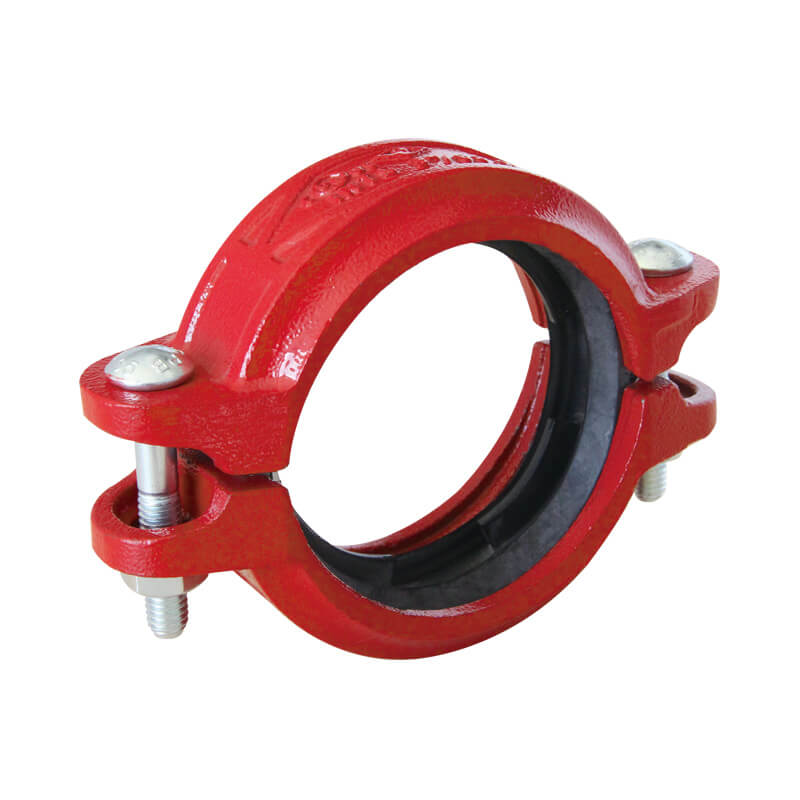
Overview and Applications
Quick flexible grooved couplings combine rapid installation with flexibility, accommodating movement in HVAC, plumbing, and industrial systems. UL/FM certified, they are ideal for dynamic environments.
Pipe Sizes and Parameters
Sizes range from 1″ to 12″ (DN25 to DN300), with pressures up to 300 PSI. The housing is ductile iron, with EPDM or nitrile gaskets and fewer bolts. Angular deflection is 1–2° for 4″ pipes.
| Size (Nominal) | Max. Working Pressure (PSI) | Angular Deflection (°) | Gasket Material | Weight (lbs) |
|---|---|---|---|---|
| 2″ (DN50) | 300 | 2.0 | EPDM/Nitrile | 3.5 |
| 4″ (DN100) | 300 | 1.5 | EPDM/Nitrile | 7.0 |
| 8″ (DN200) | 250 | 1.0 | EPDM/Silicone | 15.0 |
Detailed Analysis
These couplings reduce installation time by 20–30% while allowing flexibility for thermal expansion or vibration. The simplified bolt design maintains performance, with a robust gasket ensuring sealing. They are ideal for retrofits or seismic zones but less suited for high-pressure rigid systems. Maintenance focuses on gasket condition and bolt torque.
Comparative Data
Quick flexible couplings match standard flexible couplings in deflection (1.5° for 4″) but install faster. Compared to quick rigid couplings, they offer movement but are 10% more expensive. In HVAC, their speed and flexibility optimize system performance.
9. Plain End HDPE Coupling
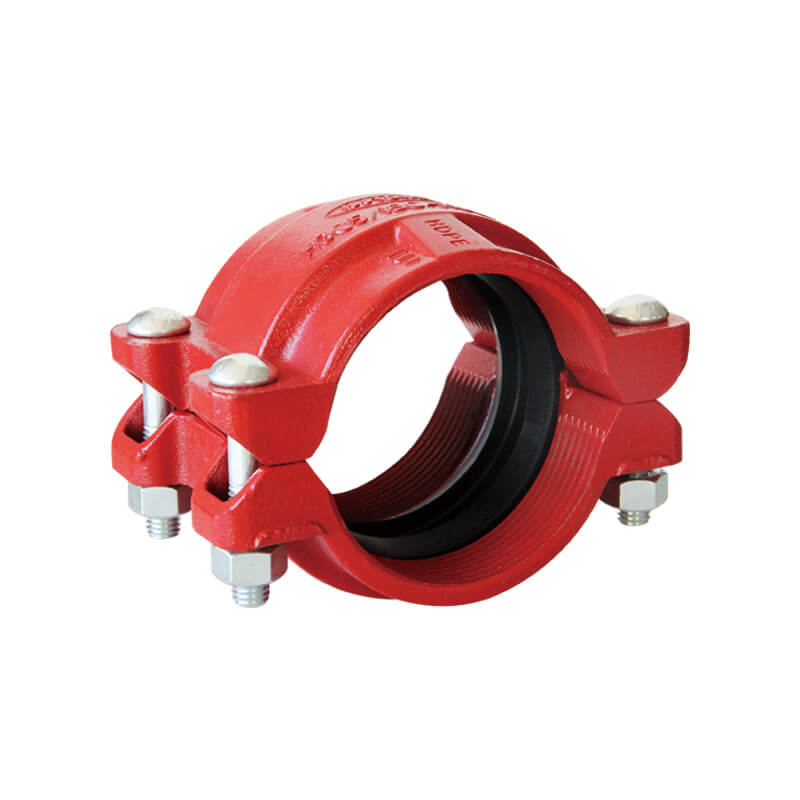
Overview and Applications
Plain end HDPE couplings connect two plain-end HDPE pipes using mechanical teeth, eliminating fusion equipment. They are used in water supply, wastewater, and industrial systems, offering a rigid joint.
Pipe Sizes and Parameters
Sizes range from 2″ to 14″ (DN50 to DN350), with pressures exceeding HDPE pipe ratings (typically 150–200 PSI). The housing is ductile iron, with EPDM gaskets and four bolts. Torque is 80–120 ft-lbs.
| Size (Nominal) | Max. Working Pressure (PSI) | Gasket Material | Bolt Torque (ft-lbs) | Weight (lbs) |
|---|---|---|---|---|
| 4″ (DN100) | 200 | EPDM | 80–100 | 10.0 |
| 8″ (DN200) | 180 | EPDM | 100–120 | 18.0 |
| 12″ (DN300) | 150 | EPDM | 120–140 | 30.0 |
Detailed Analysis
These couplings simplify HDPE pipe connections, with teeth gripping the pipe for a rigid joint. Installation is fast, saving 50–70% time over fusion welding. They are cost-effective for temporary or remote installations but less suited for high-pressure systems. Maintenance involves checking teeth engagement and gasket condition.
Comparative Data
Plain end HDPE couplings outperform fusion joints in installation speed but support lower pressures than steel couplings. They are 20–30% cheaper than transition HDPE couplings, ideal for low-pressure water lines.
10. Transition HDPE to Steel Coupling
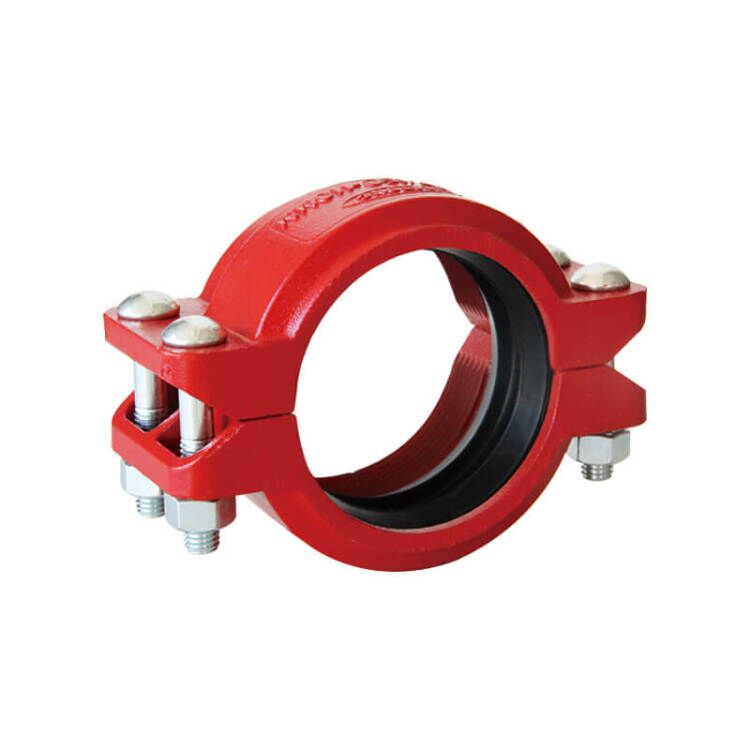
Overview and Applications
Transition HDPE to steel couplings connect HDPE pipes to steel pipes, used in water, gas, and industrial systems. Their mechanical teeth grip HDPE, while grooves engage steel, offering a rigid joint without fusion.
Pipe Sizes and Parameters
Sizes range from 2″ to 14″ (DN50 to DN350), with pressures up to 200 PSI. The housing is ductile iron, with EPDM gaskets and four bolts. Torque is 80–120 ft-lbs.
| Size (Nominal) | Max. Working Pressure (PSI) | Gasket Material | Bolt Torque (ft-lbs) | Weight (lbs) |
|---|---|---|---|---|
| 4″ (DN100) | 200 | EPDM | 80–100 | 12.0 |
| 8″ (DN200) | 180 | EPDM | 100–120 | 20.0 |
| 12″ (DN300) | 150 | EPDM | 120–140 | 35.0 |
Detailed Analysis
These couplings bridge material differences, simplifying transitions in mixed-material systems. Installation is rapid, with no need for specialized welding, saving 50–60% labor. They are robust for moderate pressures but less suited for high-pressure or dynamic systems. Maintenance checks focus on teeth grip and gasket compatibility.
Comparative Data
Transition couplings match plain end HDPE couplings in pressure but offer material versatility. They are 15–20% more expensive but reduce fitting needs in hybrid systems, saving 10–15% overall.
Scientific Comparison and Conclusion
| Coupling Type | Pressure (PSI, 4″) | Deflection (°) | Install Time | Cost Index | Best Application |
|---|---|---|---|---|---|
| Rigid Grooved | 300 | 0 | Moderate | 1.0 | Fire Protection, Fixed Systems |
| Flexible Grooved | 300 | 1.5 | Moderate | 1.1 | HVAC, Seismic Zones |
| Heavy-Duty Rigid | 400 | 0 | Moderate | 1.3 | Oil/Gas, High-Pressure |
| Heavy-Duty Flexible | 400 | 2.0 | Moderate | 1.4 | Mining, Dynamic High-Pressure |
| Reducing Flexible | 300 | 1.5 | Moderate | 1.2 | HVAC, Pipe Size Transitions |
| Quick Rigid | 300 | 0 | Fast | 1.1 | Fire Protection, Tight Schedules |
| Quikcoup One-Bolt Rigid | 250 | 0 | Very Fast | 0.9 | Low-Pressure, Rapid Install |
| Quick Flexible | 300 | 1.5 | Fast | 1.2 | HVAC, Retrofits |
| Plain End HDPE | 200 | 0 | Fast | 0.8 | HDPE Water Lines, Temporary |
| Transition HDPE to Steel | 200 | 0 | Fast | 1.0 | Mixed-Material Systems |
Grooved pipe couplings offer unmatched versatility, balancing performance, cost, and installation speed. Rigid couplings excel in stable, high-pressure systems, while flexible couplings dominate in dynamic environments. Heavy-duty variants cater to extreme conditions, and quick-install options prioritize efficiency. HDPE couplings simplify plastic pipe connections, with transition couplings bridging material gaps. Selecting the right coupling depends on pressure, movement, material, and project constraints, ensuring optimal system performance.

